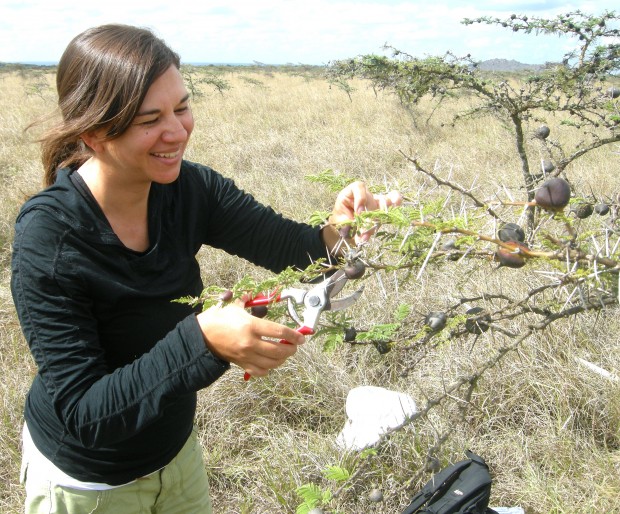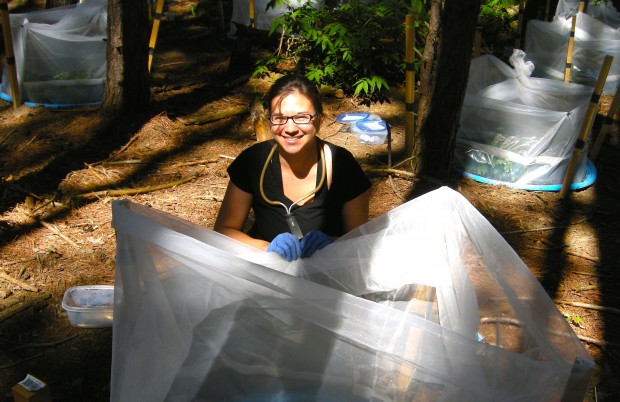Contact
priorkm@gmail.comResearch Summary
I am an ecologist with interests in the causes and consequences of species invasions and in the development of sound management strategies for invasive species. I have conducted empirical work and syntheses on the role of ecological interactions in facilitating the success of invasive species and in determining their impacts on native ecosystems. I am also interested in integrating concepts from ecology and other disciplines into the development of successful management strategies for invasive species. See more information about my research interests at: kmprior.weebly.com.Current projects
- Synthesis of successful and unsuccessful strategies for the eradication of invasive specie
Short Bio & Education
- 2015- present: School of Forest Resources and Conservation, University of Florida;Postdoctoral Research Associate
- 2013-2015: Department of Biological Sciences, University of Florida; Postdoctoral Research Associate
- 2011-2013: Department of Ecology and Evolution, University of Toronto;Department Postdoctoral Fellow
- 2011: Ph.D. in Biological Sciences, University of Notre Dame with Dr. Jessica J.Hellmann
- 1999: B.Sc. in Biological Sciences, University of Western Ontario
Publications
Prior KM, Robinson JM, Meadley Dunphy SA, Frederickson ME. 2015. Mutualism between co-introduced species facilitates invasion and alters plant community structure. Proceedings of the Royal Society B. 282:20142846
Prior KM, Powell THQ, Joseph A, Hellmann JJ. 2015. Insights from community ecology into the role of enemy release in causing invasion success: the importance of native enemy effects. Biological Invasions 17:1283-1297
Prior KM, Saxena K, Frederickson ME. 2014. Seed handling behaviors of native and invasive seed-dispersing ants differentially influence seedling emergence in an introduced plant. Ecological Entomology 39:66-74
Prior KM, Hellmann JJ. 2013. Does enemy loss cause release? A biogeographical comparison of parasitoid effects on an introduced insect. Ecology 94:1015-1024
Hellmann JJ, Prior KM, Pelini SL. 2012. The influence of species interactions on geographic range change under climate change. Annals of the New York Academy of Sciences 1249:18-2
Prior KM, Hellmann JJ. 2010. Impact of an invasive oak gall wasp on a native butterfly: a test of plant-mediated competition. Ecology 91:3284-3293
Pelini SL, Dzurisin JD, Prior KM, Williams CM, Marsico TD, Sinclair BJ, Hellmann JJ.2009. Translocation experiments with butterflies reveal limits to enhancement of poleward populations under climate change. Proceedings of the National Academy of Sciences 106:11160-11165
Prior KM, Dzurisin JD, Pelini SL, Hellmann JJ. 2009. Biology of larvae and adults of Erynnis propertius at the northern edge of its range. The Canadian Entomologist 141:161-171
Hellmann JJ, Pelini SL, Prior KM, Dzurisin JD. 2008. The response of two butterfly species to climatic variation at the edge of their range and the implications for poleward range shifts. Oecologia 157:583-592.
Books and Reviews
Powell THQ, Prior KM. 2015. Parasitism and predation. The Encyclopedia of Evolutionary Biology. Elsevier. (in press)
Prior KM, Hellmann JJ. 2014. Does enemy release contribute to the success of invasive species? A review of the enemy release hypothesis. In RP Keller, MW Cadotte, and G Sandiford, editors: Invasive Species in a Globalized World: Ecological, Social, and Legal Perspectives on Policy. University of Chicago Press. pp. 252
Pelini SL, Prior KM, Parker DJ, Dzurisin JD, Lindroth RL, Hellmann JJ. 2009. Climate change and temporal and spatial mismatches in insect communities. In TM Letcher, editor: Climate Change: Observed Impacts on Planet Earth. Elsevier, The Netherlands. pp. 215
Presentations
Prior KM. 2015. Enemy release, invasional meltdown, and elephant-fighting ants: the role of friends and foes in altered species interactions and the maintenance of keystone mutualisms. University of Florida, Department of Entomology and Nematology Seminar Series.
Prior KM. 2014. Enemy release and invasional meltdown: the role of friends and foes in facilitating the success and impacts of invasive species. Terrestrial Plant Invasive Species Conference, Mississauga ON. Keynote presentation.
Prior KM, Frederickson ME. 2013. Invasive ant alters an ecosystem service: ant identity is important in a supposedly diffuse mutualism. University of Toronto, Department Ecology and Evolutionary Biology, Attwood Colloquium.
Prior KM, Frederickson ME. 2013. Invasive ant alters an ecosystem service: the impact of co-introduced partners on seed dispersal mutualisms. 97th Ecological Society of America Annual Meeting, Milwaukee, MN.
Prior KM. 2012. Community context of range-expanding species. University of Toronto Ecology and Evolutionary Biology Seminar Series.
Prior KM, Hellmann JJ. 2010. Does enemy loss cause release? A test of the enemy release hypothesis in a range-expanding insect. 95th Ecological Society of America Annual Meeting, Pittsburgh, PA.
Prior KM, Hellmann JJ. 2010. Plant-mediated impact of an invasive oak gall wasp on a native specialist butterfly: Erynnis propertius. Garry Oak Ecosystems Recovery Team, Research Colloquium, Victoria, BC.
Prior KM, Hellmann JJ. 2009. Enemy release as a mechanism of invasion success of the Jumping gall wasp, Neuroterus saltatorius. Environmental Science Advisory Committee, Canadian Forest Service Annual Meeting, Victoria, BC.
Prior KM, Hellmann JJ. 2008. Plant-mediated interactions between and invasive oak gall wasp and a native butterfly. 93rd Ecological Society of America Annual Meeting, Milwaukee, WI.
Prior KM, Hellmann JJ. 2006. Butterfly restoration implications: lessons from a model species, Erynnis propertius. Garry Oak Restoration Workshop, Victoria, BC.
Prior KM, Hellmann JJ. 2005. Building conservation practices for butterflies using a threatened indicator species, Erynnis propertius. Symposium on Invertebrate Species at Risk in BC, Victoria, BC.


